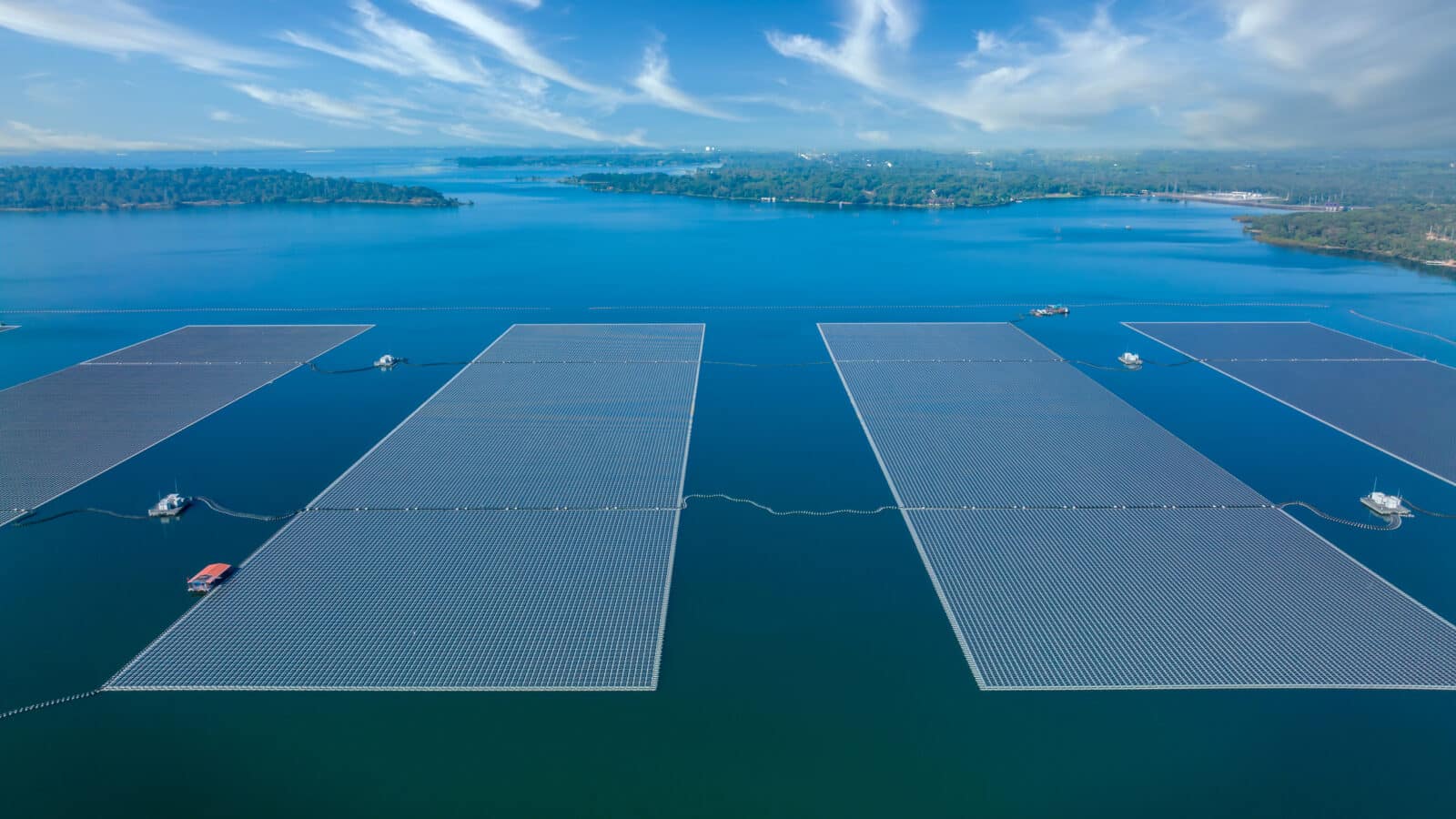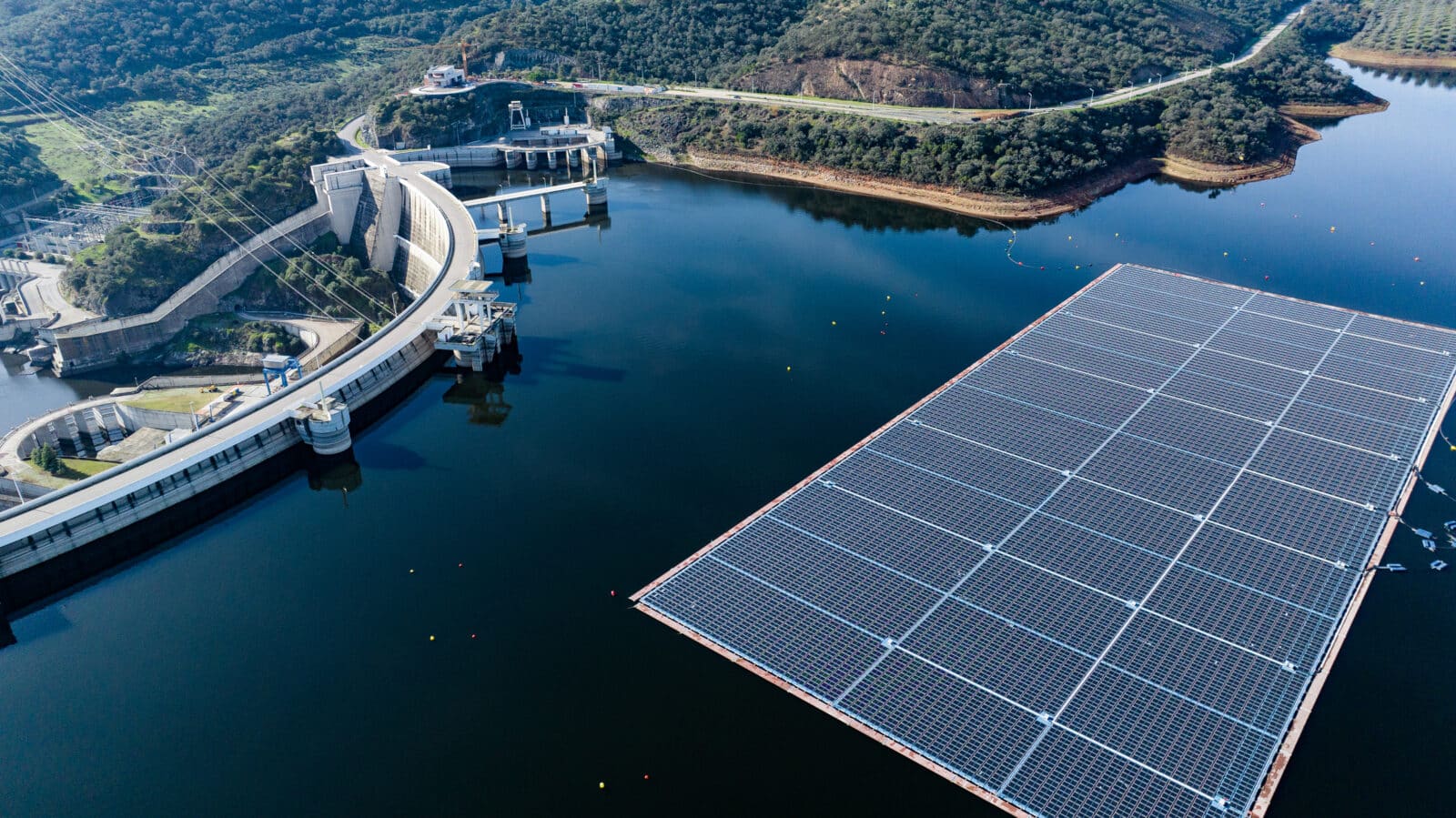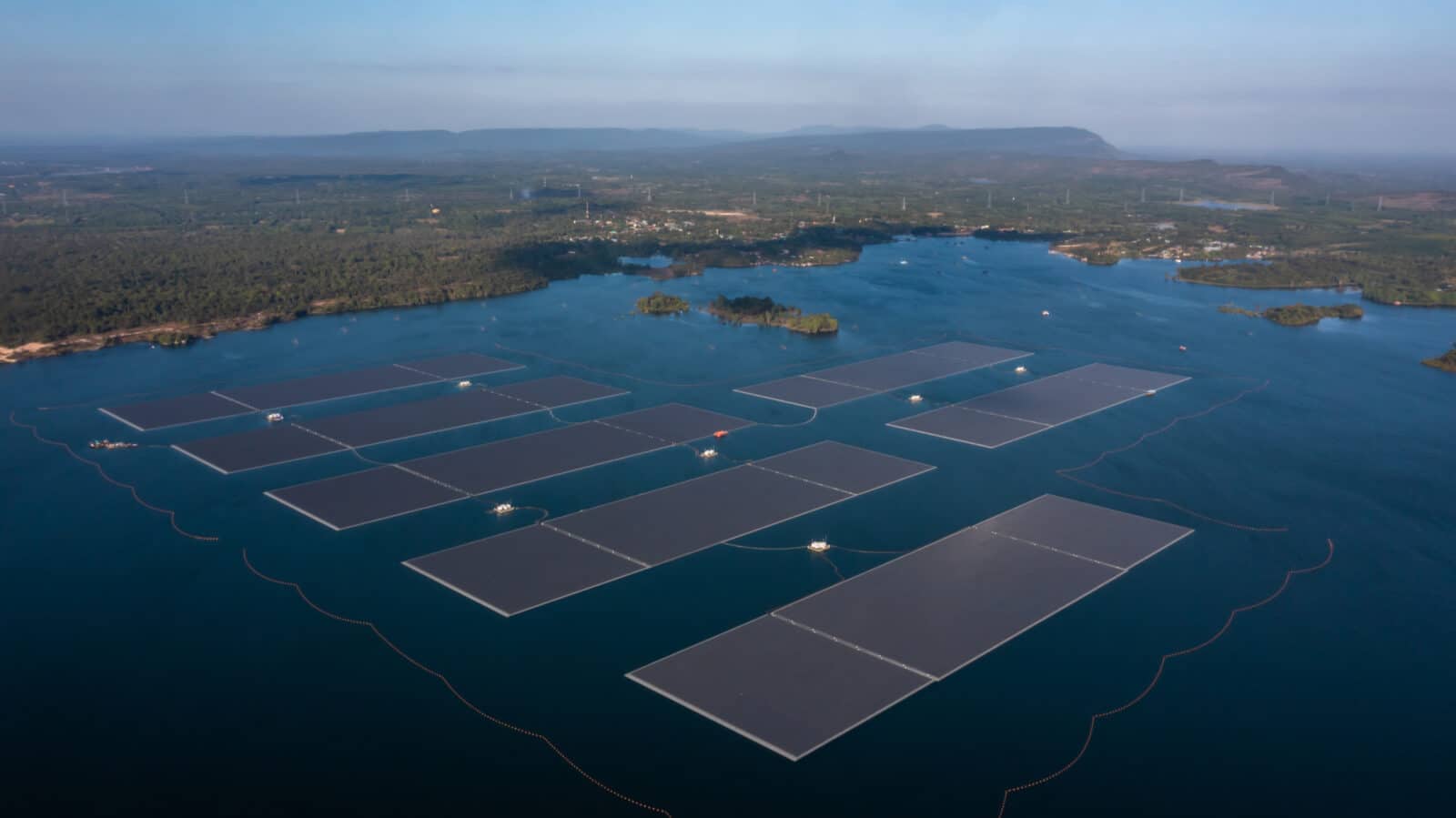The rise of floating solar panels

The wide applicability, flexibility and unseen price reductions of solar panels have contributed to the meteoric growth of PV systems in recent years. Meanwhile, solar panels on rooftops have become a matter of course in the streetscape, and people are filling up fields. The exponential growth of solar installations continues to exceed expectations year after year. The International Energy Agency even projects that solar energy will become the largest source of electricity between 2030 and 2040, judging from current trends. So why install solar panels on water, when installation on land has become so obvious and simple by now?
Source: This article was written in partnership with Techlink and published in Power+.
Lack of space
Maintaining the growth rate of PV will require a great deal of creativity. Indeed, the speed at which our electricity system is being converted to renewable energy cannot be underestimated. If we are to meet our climate targets, the growth of renewables will have to be faster than electrification itself, in a context where the world’s final energy consumption is still rising. Although there is still a huge amount of suitable space available, including on roofs, it is worth looking to the future. Over time, competition for available space will intensify, especially in densely populated areas such as Western Europe. Agriculture, housing, industry, recreation and nature are all competing for the same land. Although we are still a long way off, over time this will affect the growth of solar power. Although PV modules are easier than ever to integrate into the environment, solar energy is not immune to public opposition. Large infrastructure is not welcome everywhere, and the “not in my backyard” or NIMBY syndrome is not limited to wind farms. Yet it is in densely populated regions that the demand for electricity is typically greatest. That’s where solar power is most needed.
Floating solar panels offer a solution[1]. The technology makes it possible to install large numbers of solar panels without compromising other uses of space. They are already being installed commercially on ponds, small lakes and flooded mines or former quarries. Commercial floats and anchors are now available for these calm, shallow waters. They often use HDPE (high-density polyethylene) for the floats, a material that is inexpensive and fairly strong, but also resistant to corrosion and UV radiation. The same mass production of standard components that has driven down the price of PV modules is also enabling cheaper, off-the-shelf solutions for calm waters. In addition, the search for suitable structures and materials for the introduction of innovative floating solar installations at sea is in full swing.

A solution with added value
Floating solar offers scalability on previously unused land. Installing solar panels on water also brings unexpected benefits. The underlying water allows the heat generated by the PV modules to be partially absorbed. As a result, the panels operate at a lower temperature than on land and energy conversion is more efficient. Typically, an efficiency gain of 2 to 3% can be expected, depending on the location.
Covering water also affects the underlying ecosystem. This can be both beneficial and detrimental. By blocking some of the sunlight, it can prevent algae growth and keep the water cooler, improving water quality. This is the effect that plastic sheeting or balls in storage ponds are usually designed to achieve. In this way, it is possible to combine several functions: both ensuring water quality and generating electricity. Finally, the solar panels also prevent some evaporation, which is useful during prolonged periods of drought. Completely covering the water may even prevent any biological development in the absence of light. It is therefore necessary to weigh up the desired effects before deciding on the size and location of the installation.
Floating solar panels and hydropower
In addition to the advantages mentioned above, floating solar panels can also be installed in combination with hydropower plants or offshore wind turbines. The ability to share grid connections makes this an attractive option. In this way, grid infrastructure costs can be reduced. Hydropower plants already have a fixed connection with limited full-load hours. A significant amount of solar energy can therefore be integrated via the same connection. This increases the installed capacity, and the combination of a weather-dependent power source such as PV with a fully controllable hydro plant also provides the necessary flexibility.
The largest floating solar installation combined with hydropower is currently located in West Java, Indonesia, on the reservoir of the Cirata hydropower plant (1 GW). Inaugurated in November 2023, the plant has more than 300,000 PV modules spread across 13 islands. These are supported by around 750,000 floats held in place by around 2,000 concrete anchors. This equates to a floating area of 250 hectares. With water depths of up to 100m, the project is unique in the world and demonstrates the scalability of the technology. The project, with a capacity of around 192 MWp, has been designed to meet the growing demand for renewable energy without taking up valuable space in the surrounding countryside, which is mainly used for agriculture. The floating solar farm is expected to generate 300 GWh of electricity per year[2].

Hybrid offshore solar-wind farms
In addition to productive combinations with hydroelectric power, investment is also being made in efficient combinations of floating solar panels with offshore wind energy. Despite the additional costs compared to onshore wind farms, offshore wind farms are now a great success and are becoming a solid pillar of our electricity supply. The offshore wind zones, which are already inaccessible to commercial shipping and fishing, have a lot of available surface area suitable for floating solar panels. The immensity of the space available makes it possible to consider the development of megawatt and even gigawatt systems, a scale no longer possible for land-based solar installations in our region.
Again, sharing the grid connection can reduce the cost of cables and other offshore electrical infrastructure. This is a good thing, because investments in grid expansion are included in the electricity bill. It is important to note that wind turbines and solar panels are most productive at different times of the year. The complementarity of renewable energy sources allows for a staggered load on the grid connection. [3] In this way, the integration of offshore floating solar power can significantly increase the electrical output of wind zones without a fundamental expansion of the grid connection. Combined solar-wind farms thus offer prospects for efficient and scalable further deployment of offshore renewable energy.
Grand challenges and pioneering test facilities
Alongside the undeniable potential, there are serious challenges associated with this young technology. For example, the floats will always represent a systematic additional cost compared to less material-intensive installations on land. Indeed, the constant swelling of the platforms also places new demands on the materials, which must be resistant to fatigue, UV radiation, corrosion, etc.
The promise of unprecedented scale and synergy with offshore wind is therefore matched by significant challenges, particularly for floating solar power at sea, where high waves, strong winds and corrosive corrosion, among other things, complicate matters. In the race to capture this very young but promising market, the Dutch companies SolarDuck and Oceans of Energy and the Belgian consortium SeaVolt (a collaboration between Jan De Nul, DEME and Tractebel) are leading the way. The strong presence of industry and research institutions in the Low Countries, combined with expertise in offshore wind, makes the region ideally suited for innovation in this sector. Each company is experimenting with its own approach and implementation. For example, SeaVolt and SolarDuck are opting for taller structures that keep the PV modules several metres above the water surface, protecting them from the effects of wave action, corrosion and algae growth, while Oceans of Energy is opting for a more modest structure that keeps the modules close to the water. SolarDuck has developed marine aluminium structures with three floats and recently commissioned its 500 kWp ‘Merganser’ test installation 12 km off the coast of Scheveningen. The company is also working on a 5 MWp system to be installed at the ‘Hollandse Kust West’ wind farm as part of the European ‘Nautical Sunrise’ project in the coming years. [4] In contrast to SolarDuck’s marine aluminium, SeaVolt is experimenting with fibre-reinforced plastic (FFR), which is particularly light and corrosion-resistant.[5] SeaVolt launched a small test installation off the coast of Ostend in the summer of 2023, where Oceans of Energy’s third test installation is now located. Their rectangular floats keep the modules close to the water surface. This reduces structural costs, but also makes the PV modules more vulnerable to the effects of waves, seawater and algae. Nevertheless, the Oceans of Energy structures have an impressive track record, with test rigs having survived North Sea storms and 13-metre waves. Like SolarDuck, Oceans of Energy plans to integrate its first floating solar array with a wind farm in the Dutch North Sea by 2025. Only the future can tell which of these options will ultimately prove to be the most reliable and cost-effective. What is certain is that floating solar is here to stay, and that we in the Netherlands have what it takes to be at the forefront of this emerging sector.

Want to learn more?
Find out more about the potential of solar energy and the future of floating solar panels in our comprehensive research portal. Read more here.
Sources
[1] A floating solar panel project even won awards at last year’s Techlink Awards Night. Ministry of Solar received a Sustainable Renovation Award for a floating solar energy system on the site of a Les Petons quarry in Yves-Gomezée. It is the largest floating installation in Wallonia. Source: September edition Power+ 2023.
[2] A. Garanovic, “The largest floating solar power plant in Southeast Asia comes online,” Offshore Energy. Visited: Jul. 12, 2024. [Online] https://www.offshore-energy.biz/ the-largest-floating-solar-powerplant-in-southeast-asia-comesonline/
[3] O. Delbeke, J. D. Moschner, and J. Driesen, “The complementarity of offshore wind and floating photovoltaics in the Belgian North Sea, an analysis up to 2100,” Renew Energy, vol. 218, Dec. 2023, doi: 10.1016/j.renene.2023.119253.
[4] Engineeringnet, “Bouw grootste offshore drijvende zonneenergiesysteem ter wereld.” Visited: Jul. 12, 2024. [Online]: https://engineeringnet.be/nl/nieuws/ item/22733/bouw-grootste-offshoredrijvende-zonne-energiesysteemter-wereld
[5] VLAIO, “Consortium Seavolt lanceert binnenkort eerste drijvende zonnepanelen.” Visited: Jul. 12, 2024. [Online]. Available: https:// www.vlaio.be/nl/nieuws/consortiumseavolt-lanceert-binnenkort-eerstedrijvende-zonnepanelen
